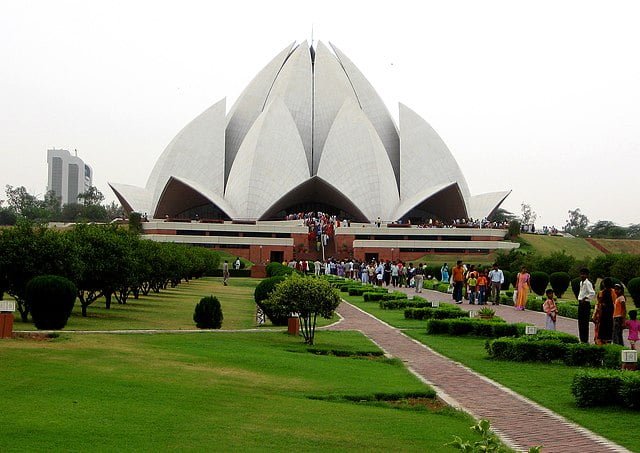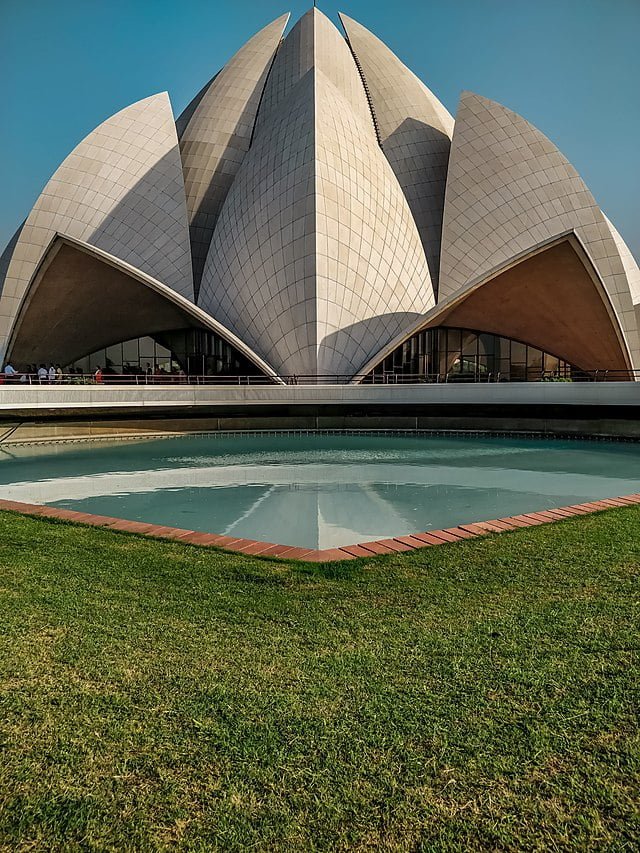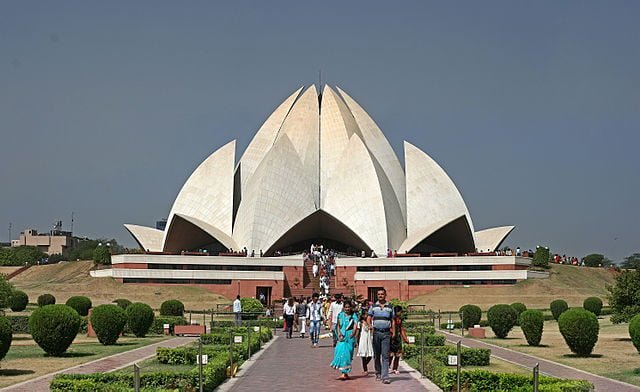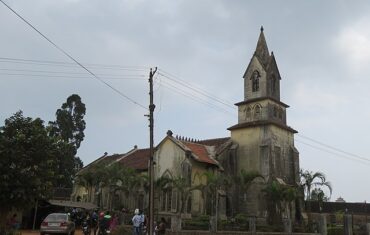The Lotus Temple, located in New Delhi, India, is a Baháʼí House of Worship that was dedicated in December 1986. Notable for its lotus-like shape, it has become a prominent attraction in the city. Like all Baháʼí Houses of Worship, the Lotus Temple is open to all, regardless of religion or any other qualification. Visit during Delhi Local sightseeing by cab
Overview of Lotus Temple

The Lotus Temple is composed of 27 free-standing marble-clad “petals” arranged in clusters of three to form nine sides, with nine doors opening onto a central hall with a height of slightly over 34 meters and a capacity of 1,300 people. The Lotus Temple has won numerous architectural awards and has been featured in many newspaper and magazine articles
The Lotus Temple stands for the principle of the oneness of humankind and welcomes people of all racial, religious, and national backgrounds to pray and meditate within its precincts. It is a collective centre of society to promote cordial affection where everyone is held in its embrace as equals. This edifice is dedicated to the one God, the Creator of all humanity and of the entire universe
Lotus Temple Location/ Timing and Entry Fees

The Lotus Temple is located in Kalkaji, a suburb in south Delhi. It is easily accessible by metro, bus, auto-rickshaw or taxi. The nearest metro station is Kalkaji Mandir on the Violet Line.
The Lotus Temple is open from Tuesday to Sunday, from 9:00 am to 5:00 pm (winter) or 7:00 pm (summer). It is closed on Mondays and on Baháʼí holy days. The entry to the temple is free of charge. However, visitors are requested to maintain silence and respect inside the temple premises. Photography is not allowed inside the temple hall.
How to Reach Lotus Temple

There are various ways to reach the Lotus Temple from different parts of Delhi and nearby cities. Here are some of the options:
- By Metro: The most convenient and economical way to reach the Lotus Temple is by metro. The nearest metro station is Kalkaji Mandir on the Violet Line, which is about 500 meters away from the temple. From there, one can walk or take an auto-rickshaw to the temple gate.
- By Bus: There are several buses that ply to and from the Lotus Temple from different parts of Delhi. Some of the bus routes are 427, 433, 460, 507, 534A, 534B, etc. One can alight at Nehru Place or Kalkaji bus stop and walk or take an auto-rickshaw to the temple gate.
- By Auto-Rickshaw or Taxi: One can also hire an auto-rickshaw or a taxi from any part of Delhi to reach the Lotus Temple. The fare may vary depending on the distance and traffic conditions.
- By Car: If one has a private car or a rented vehicle, one can drive to the Lotus Temple by following the directions on Google Maps or other navigation apps. There is a parking lot near the temple gate where one can park their vehicle for a nominal fee.
Significance of Lotus Temple

The Lotus Temple is not only a beautiful architectural marvel but also a spiritual sanctuary for people of all faiths and backgrounds. It is a place where one can experience peace, harmony and unity with God and His creation.
The Lotus Temple represents the lotus flower, which symbolizes purity, beauty and divinity in many cultures and religions. The lotus also signifies the unfolding of the potentialities of the human soul under the guidance of God’s Manifestations.
The Lotus Temple follows the teachings of the Baháʼí Faith, which is a world religion that believes in one God, one humanity and one religion. The Baháʼí Faith teaches that God has sent a succession of Divine Messengers, such as Abraham, Moses, Buddha, Zoroaster, Jesus Christ, Muhammad and Bahá’u’lláh (the founder of the Baháʼí Faith), to educate and guide humanity.
The Lotus Temple highlights the importance of prayer in the life of individuals and communities. It provides a space for expressing that desire to communicate with our Creator through prayer that is conceived as “the essential spiritual conversation of the soul with its Maker”. It further underscores the significance of collective worship as a fundamental element of a pattern of community life that is spiritually and materially prosperous.
FAQ’s
Q: How long does it take to visit the Lotus Temple?
A: It depends on how much time one wants to spend in the temple hall and the surrounding gardens. Generally, it takes about an hour to visit the temple and enjoy its serene atmosphere.
Q: What are the timings of the devotional services at the Lotus Temple?
A: The devotional services at the Temple are held four times a day, at 10:00 am, 12:00 noon, 3:00 pm and 5:00 pm (winter) or 6:00 pm (summer). Each service lasts for about 15 minutes and consists of readings from the sacred scriptures of various religions.
Q: Can one perform rituals or ceremonies at the Lotus Temple?
A: No, the Temple does not allow any rituals or ceremonies to be performed inside or outside its premises. The temple is meant for individual and collective worship only.
Q: Can one donate money or materials to the Lotus Temple?
A: No, the Temple does not accept any donations from the public. The temple is maintained by the voluntary contributions of the Baháʼí community.
Q: Can one volunteer at the Lotus Temple?
A: Yes, one can volunteer at theTemple by registering at the information desk near the entrance. The volunteers help in guiding the visitors, maintaining cleanliness and orderliness, and participating in various activities and programs.
Conclusion
The Temple is a unique and inspiring place that offers a glimpse of the Baháʼí vision of a world where people of all faiths and backgrounds can live together in peace and harmony. It is a place where one can experience the beauty and power of prayer and meditation, and feel connected to God and His creation. It is a place where one can learn about the Baháʼí Faith and its teachings of unity, justice and service. It is a place where one can join hands with others in building a better world for all.











Comments are closed.